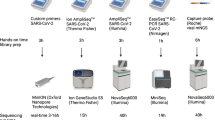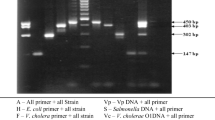Abstract
Human rotavirus (HRV), adenovirus (HAdV), and norovirus (HNV) are the most common causes of viral gastroenteritis in humans worldwide. Application of quantitative PCR (qPCR) coupled with reverse transcription (RT), known as RT-qPCR, has greatly improved detection sensitivity for enteric viruses, but it has been mostly used in monoplex mode where only a single virus type can be quantified per assay. Here, we report the development of a simple and specific multiplex RT-qPCR assay for simultaneous quantification of rotavirus, adenovirus, and norovirus in ground water, river water, and wastewater samples. For all three virus groups, the monoplex and multiplex RT-qPCR yielded virtually identical PCR efficiency, dynamic quantification range, and detection sensitivity, indicating the reliability of the multiplex RT-qPCR assay for simultaneous quantification of three viruses. The multiplex assay also accurately quantified the target genes of a small number (40 copies per PCR) in the presence of competing viral genes of up to 104-fold more abundant. Specificity of the assay was estimated to be 100 % for all three viruses when tested against 19 common waterborne microorganisms. The results showed that our multiplex RT-qPCR assay holds considerable promise in quantifying the three enteric viruses in environmental water samples.


Similar content being viewed by others
References
Arnold, M., Patton, J.T., & McDonald, S.M. (2009). Culturing, storage, and quantification of rotaviruses. Current Protocols in Microbiology, (15), Unit 15C.3.
Brown, M. (1990). Laboratory identification of adenoviruses associated with gastroenteritis in Canada from 1983 to 1986. Journal of Clinical Microbiology, 28, 1525–1529.
Bustin, S. A., Benes, V., Garson, J. A., Hellemans, J., Huggett, J., Kubista, M., Mueller, R., Nolan, T., Pfaffl, M. W., Shipley, G. L., Vandesompele, J., & Wittwer, C. T. (2009). The MIQE guidelines: minimum information for publication of quantitative real-time PCR experiments. Clinical Chemistry, 55, 611–622.
Butot, S., Le Guyader, F. S., Krol, J., Putallaz, T., Amoroso, R., & Sánchez, G. (2010). Evaluation of various real-time RT-PCR assays for the detection and quantitation of human norovirus. Journal of Virological Methods, 167, 90–94.
Centers for Disease Control and Prevention (2015). Norovirus: US trends and outbreaks. http://www.cdc.gov/norovirus/trends-outbreaks.html.
Fittipaldi, M., Rodriguez, N. J. P., Codony, F., Adrados, B., Peñuela, G. A., & Morató, J. (2010). Discrimination of infectious bacteriophage T4 virus by propidium monoazide real-time PCR. Journal of Virological Methods, 168, 228–232.
Fong, T. T., Phanikumar, M. S., Xagoraraki, I., & Rose, J. B. (2010). Quantitative detection of human adenoviruses in wastewater and combined sewer overflows influencing a Michigan river. Applied and Environmental Microbiology, 76, 715–723.
Gray, J. (2011). Rotavirus vaccines: safety, efficacy and public health impact. Journal of Internal Medicine, 270, 206–214.
Hall, A. J., Vinjé, J., Lopman, B., Park, G., Yen, C., Gregoricus, N., & Parashar, U. (2011). Updated norovirus outbreak management and disease prevention guidelines. Morbidity and Mortality Weekly Report, 60(RR03), 1–15.
Hamza, I. A., Jurzik, L., Überla, K., & Wilhelm, W. (2011). Methods to detect infectious human enteric viruses in environmental water samples. International Journal of Hygiene and Environmental Health, 214, 424–436.
Hlavsa, M., Roberts, V. A., Kahler, A. M., Hilborn, E. D., Mecher, T. R., Beach, M. J., Wade, T. J., & Yoder, J. S. (2015). Outbreaks of Illness associated with recreational water—United States, 2011–2012. Morbidity and Mortality Weekly Report, 64, 668–672.
Jiang, Y., Fang, L., Shi, X., Zhang, H., Li, Y., Lin, Y., Qiu, Y., Chen, Q., Li, H., Zhou, L., & Hu, Q. (2014). Simultaneous detection of five enteric viruses associated with gastroenteritis by use of a PCR assay: a single real-time multiplex reaction and its clinical application. Journal of Clinical Microbiology, 52, 1266–1268.
Jothikumar, N., Lowther, J. A., Henshilwood, K., Lees, D. N., Hill, V. R., & Vinjé, J. (2005). Rapid and sensitive detection of Noroviruses by using TaqMan-based one-step reverse transcription-PCR assays and application to naturally contaminated shellfish samples. Applied and Environmental Microbiology, 71, 1870–1875.
Kageyama, T., Kojima, S., Shinohara, M., Uchida, K., Fukushi, S., Hoshino, F. B., Takeda, N., & Katayama, K. (2003). Broadly reactive and highly sensitive assay for norwalk-like viruses based on real-time quantitative reverse transcription-PCR. Journal of Clinical Microbiology, 41, 1548–1557.
Karim, M.R., Rhodes, E.R., Brinkman, N., Wymer, L., & Fout, G.S. (2009). New electropositive filter for concentrating enteroviruses and noroviruses from large volumes of water. Applied and Environmental Microbiology, 75, 2393–2399.
Knight, A., Li, D., Uyttendaele, M., & Jaykus, L.-A. (2013). A critical review of methods for detecting human noroviruses and predicting their infectivity. Critical Reviews in Microbiology, 39, 295–309.
Lee, D. Y., Shannon, K. E., & Beaudette, A. L. (2006). Detection of bacterial pathogens in municipal wastewater using an oligonucleotide microarray and real-time quantitative PCR. Journal of Microbiological Methods, 65, 453–467.
Li, L., Phan, T. G., Nguyen, T. A., Kim, K. S., Seo, J. L., Shimizu, H., Suzuki, E., Okitsu, S., & Ushijima, H. (2005). Molecular epidemiology of adenovirus infection among pediatric population with diarrhea in Asia. Microbiology and Immunology, 49, 121–128.
Pang, X. L., Lee, B. E., Pabbarajua, K., Gabosd, S., Craike, S., Payment, P., & Neumann, N. (2012). Pre-analytical and analytical procedures for the detection of enteric viruses and enterovirus in water samples. Journal of Virological Methods, 184, 677–683.
Pang, X. L., Preiksaitis, J. L., & Lee, B. E. (2013). Enhanced enteric virus detection in sporadic gastroenteritis using a multi-target real-time PCR panel: a one-year study. Journal of Medical Virology, 86, 1594–1601.
Parshionikar, S., Laseke, I., & Fout, G. S. (2010). Use of propidium monoazide in reverse transcriptase PCR to distinguish between infectious and noninfectious enteric viruses in water samples. Applied and Environmental Microbiology, 76, 4318–4326.
Rice, E.W., Baird, R.B., Eaton, A.D., & Clesceri, L.S. (2012). Standard methods for the examination of water and wastewater, 22nd ed. American Public Health Association, American Water Works Association, and Water Environment Federation, Washington DC.
Sdiri-Loulizi, K., Gharbi-Khelifi, H., de Rougemont, A., Hassine, M., Chouchane, S., Sakly, N., Pothier, P., Guediche, M. N., Aouni, M., & Ambert-Balay, K. (2009). Molecular epidemiology of human astrovirus and adenovirus serotypes 40/41 strains related to acute diarrhea in Tunisian children. Journal of Medical Virology, 81, 1895–1902.
Stals, A., Baert, L., Botteldoorn, N., Werbrouck, H., Herman, L., Uyttendaele, M., & Coillie, E. V. (2009). Multiplex real-time RT-PCR for simultaneous detection of GI/GII noroviruses and murine norovirus I. Journal of Virological Methods, 161, 247–253.
Topping, J. R., Schnerr, H., Haines, J., Scott, M., Carter, M. J., Willcocks, M. M., Bellamy, K., Brown, D. W., Gray, J. J., Gallimore, C. I., & Knight, A. I. (2009). Temperature inactivation of Feline calicivirus vaccine strain FCV F-9 in comparison with human noroviruses using an RNA exposure assay and reverse transcribed quantitative real-time polymerase chain reaction—a novel method for predicting virus infectivity. Journal of Virological Methods, 156, 89–95.
Tran, T. N. H., Trainor, E., Nakagomi, T., Cunliffe, N. A., & Nakagomi, O. (2013). Molecular epidemiology of noroviruses associated with acute sporadic gastroenteritis in children: global distribution of genogroups, genotypes and GII.4 variants. Journal of Clinical Virology, 56, 185–193.
van Frankenhuyzen, J. K., Trevors, J. T., Lee, H., Flemming, C. A., & Habash, M. B. (2011). Molecular pathogen detection in biosolids with a focus on quantitative PCR using propidium monoazide for viable cell enumeration. Journal of Microbiological Methods, 87, 263–272.
van Maarseveen, N. M., Wessels, E., de Brouwer, C. S., Vossen, A. C. T. M., & Claas, E. C. J. (2010). Diagnosis of viral gastroenteritis by simultaneous detection of adenovirus group F, astrovirus, rotavirus group A, norovirus genogroups I and II, and sapovirus in two internally controlled multiplex real-time PCR assays. Journal of Clinical Virology, 49, 205–210.
Vidovic, S., Aly, M., Flemming, C., Springthorpe, S., & Sattar, S. A. (2011). First evidence of genotypes Ad3a16 and Ad3a18 in North America, obtained by genetic analysis of infectious human adenovirus from wastewaters of two urban communities in Canada. Applied and Environmental Microbiology, 77, 4256–4259.
Wong, K., Fong, T.-T., Bibby, K., & Molina, M. (2012). Application of enteric viruses for fecal pollution source tracking in environmental waters. Environment International, 45, 151–164.
Acknowledgments
The authors express gratitude to Ms. N. McLellan and C. Lofranco (U. of Guelph) and Laboratory Services Branch of Ontario Ministry of the Environment and Climate Change for their field sampling work.
Author information
Authors and Affiliations
Corresponding author
Ethics declarations
Funding
This research was funded by the Ontario Ministry of the Environment and Climate Change Best in Science program (Project number 1314043).
Conflict of Interest
The authors declare that they have no conflict of interest.
Rights and permissions
About this article
Cite this article
Lee, DY., Leung, K.T., Lee, H. et al. Simultaneous Detection of Selected Enteric Viruses in Water Samples by Multiplex Quantitative PCR. Water Air Soil Pollut 227, 107 (2016). https://doi.org/10.1007/s11270-016-2811-5
Received:
Accepted:
Published:
DOI: https://doi.org/10.1007/s11270-016-2811-5




